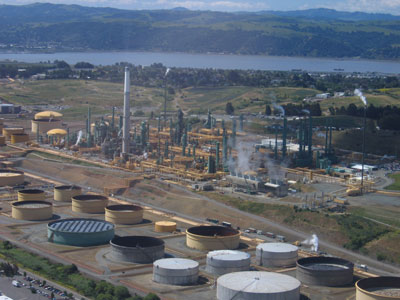Carbon dioxide is “not pollution,” say engineers for the nation’s biggest refiner.
Listen to Rachael Myrow’s radio feature on The California Report.

Last week, as the campaign rhetoric for and against Proposition 23 was heating up, The California Report host Rachael Myrow and I spent an afternoon with three of Valero’s environmental specialists at the company’s refinery in Benicia, up the Sacramento River from San Francisco Bay. They briefed us on the refining process in some detail and drove us around the 400-acre refinery site, near the Carquinez Strait in Solano County.
Valero has been in the spotlight as the largest single contributor to Prop 23, with more than $4 million in the game. The company maintains two medium-sized refineries in California. The Benicia plant produces gasoline, diesel and jet fuel, as well as most of the asphalt used to pave highways in northern California. Unless halted by Prop 23, the cap-and-trade system of carbon pricing under the state’s greenhouse gas law (AB 32) would likely cost refiners millions in emissions fees.
“Our refinery operates under some of the most strict emission limits that exist anywhere in the world,” said Chris Howe, who directs health, safety and environmental affairs at the plant. But Howe and his co-managers made it clear that they don’t consider carbon dioxide emissions to be “pollution.” It should be noted that regulators, including the federal Environmental Protection Agency, appear to differ with that. In a landmark “endangerment finding,” the EPA concluded that greenhouse gases such as CO2 “threaten the public health and welfare of current and future generations.” The published finding also uses the term “greenhouse gas pollution.” Clearly CO2 presents a different kind of threat than “local” air pollutants such as sulfur dioxide (SO2) and oxides of nitrogen (NOX), the building blocks of smog. But Kristine Roselius of the Bay Area Air Quality Management District says that distinction may be overblown. “When you reduce GHGs (greenhouse gases), you reduce smog and soot pollution,” wrote Roselius in an email.
Howe says his facility has to comply with 50,000 individual requirements under various environmental laws. “It’s a continuous challenge to maintain compliance with all of those,” said Howe, who maintains a staff of ten people who monitor environmental compliance full-time.
Don Cuffel, Valero’s lead environmental engineer at Benicia, says that the company has spent $650 million over the past five years, adding systems to keep SO2 and NOX out of the air. Cuffel says that keeping a lid on those local pollutants while reducing greenhouse gases presents them with a dilemma, since all that added equipment requires energy to run, and a natural byproduct of combustion is…CO2.
Asked how he feels when he hears critics refer to Valero as one of the “toxic twins” (with neighboring Tesoro), Howe says: “It’s fairly easy and common for people to make statements like that but it typically comes from a real ignorance of our business. I’ve been in the environmental management business for the majority of my career,” said Howe. “We strive to get out and explain to people what we do. We’re proud of our performance and are seeking to be in compliance with all rules, all the time.”
Clearly they’re not entirely successful, as was highlighted last week, when Prop 23 opponents released a list of 120 environmental violations at the Benicia refinery, since 2007 (200 at Tesoro, across the river). Howe estimated that 10% of the Valero citations resulted in some detectable effect on the local community, such as a “nuisance odor,” and that most were self-reported to regulators, by the company. “By no means would I consider these significant and putting folks in harm’s way,” said Howe.
In response to an email query on that topic, Roselius of the Air Quality District wrote that all of the Bay Area’s five major oil refineries tend to generate similar numbers of citations. Last week directors at the District added theirs to the list of organizations officially opposing Prop 23.
You can take a brief tour of Valero’s Benicia refinery in the slide show, below:
